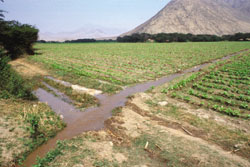
Posted April 27, 2001.
|
Archaeologists have announced a secure date of 2627 B.C. for the earliest parts of the site of Caral in Peru. This city displayed monumental architecture far earlier than previously imagined for the New World.
For comparison, the first of Egypt's great pyramids were built about 4,560 years ago by the pharaoh Cheops, while Caral, which had pyramids of its own, dates to more than 4,600 years ago. Caral's pyramids, which surrounded a large, circular plaza, were filled with rubble and rocks, which were transported to the site by hordes of workers in woven bags made of reeds. It was this organic material which permitted accurate radiocarbon dating. Caral was built before the domestication of grain. Apparently the inhabitants bartered with coastal residents for the seafood which served as their main protein source. In return, they traded primarily cotton, which the fisherman used to make nets. Caral must have had a system of irrigation in order to grow the cotton, as well as such crops as beans and squash. For more information, see the San Francisco Chronicle. Also see the transcript of this BBC documentary. |
home

